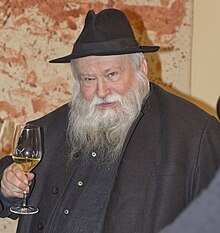Hermann Nitsch
| Hermann Nitsch | |
|---|---|

Hermann Nitsch, 2012
|
|
| Born |
August 29, 1938 Vienna |
| Nationality | Austrian |
| Education | Wiener Graphische Lehr-und Versuchanstalt |
| Known for | Performance art, music |
| Notable work | Orgien Mysterien Theater |
| Movement | Vienna Actionists |
| Website | [1] |
Hermann Nitsch (born 29 August 1938) is an Austrian avant-garde artist who works in experimental and multimedia modes.
Born in Vienna, Nitsch received training in painting when studied at the Wiener Graphische Lehr-und Versuchanstalt, during which time he was drawn to religious art. He is associated with the Vienna Actionists—a loosely affiliated group of off-kilter and confrontational Austrian artists that also includes Günter Brus, Otto Muehl, and Rudolf Schwarzkogler.
Nitsch's abstract 'splatter' paintings, like his performance pieces, are inspired by his neutral perspective on humanity and being human. In the 1950s, Nitsch conceived of the Orgien Mysterien Theater (which roughly translates as Theatre of Orgies and Mysteries or The Orgiastic Mystery Theater), staging nearly 100 performances between 1962 and 1998.
In 1966 he was with Gustav Metzger, Otto Muehl, Wolf Vostell, Juan Hidalgo and others a participant of the Destruction in Art Symposium (DIAS) in London.
Nitsch's Orgies Mysterien Theater performances (or Aktionen, as he calls them) can be considered both ritualistic and existential. The scene is often involved with slaughters, religious sacrifices, crucifixion, as well as blood and flesh. The performances are also accompanied with music, dancing, and active participants. In his first Orgien Mysterien Theater performance, Nitsch and his friends used animal carcasses, entrails, and blood similarly to a ritual. The cloths, bandages and other fabrics used in these performances introduced Nitsch to the idea of making paintings.
Having grown up during the World War II, Nitsch reveals his fascination with the intensity of religious feelings for life in his art work with excessive means such as taboo images, nudity, bloody scenes and more. For this, he received several court trials and three prison terms. It is often suggested that his work may exemplify cultures' fascination with violence.
...
Wikipedia
